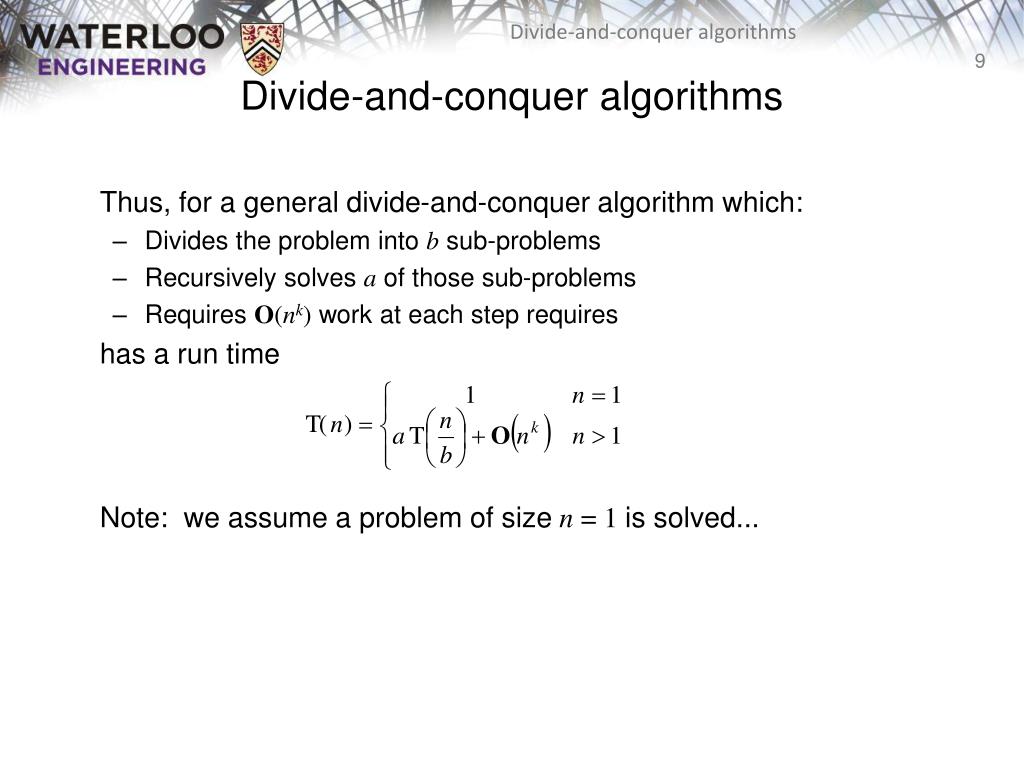

double (minmatrix (Matrix M)) return minmatrix2 (M, 0, 0, M.row) (the Matrix type is given, and as you can imagine M.row gives the number of rows and columns of the matrix). The cookie is set by the GDPR Cookie Consent plugin and is used to store whether or not user has consented to the use of cookies. In the divide and conquer approach, firstly a problem is divided into smaller problems, then these smaller problems are solved independently, and then finally. Calculate its minimum value using a recursive function. The cookie is used to store the user consent for the cookies in the category "Performance". This cookie is set by GDPR Cookie Consent plugin. The cookie is used to store the user consent for the cookies in the category "Other. The cookies is used to store the user consent for the cookies in the category "Necessary". Divide We divide the original problem into multiple sub-problems until they cannot be divided further. The cookie is set by GDPR cookie consent to record the user consent for the cookies in the category "Functional". The common procedure for the divide and conquer design technique is as follows. The cookie is used to store the user consent for the cookies in the category "Analytics". A divide and conquer algorithm works just like it sounds. These cookies ensure basic functionalities and security features of the website, anonymously. The next most common algorithmic technique is divide and conquer.

Its the combine step, where you have to merge two sorted subarrays, where the real work happens. You have to make two recursive calls in the conquer step. Finding the midpoint q q in the divide step is also really easy. Necessary cookies are absolutely essential for the website to function properly. Most of the steps in merge sort are simple. The name decrease and conquer has been proposed instead for the single-subproblem class. Therefore, some authors consider that the name “divide and conquer” should be used only when each problem may generate two or more subproblems. Under this broad definition, however, every algorithm that uses recursion or loops could be regarded as a “divide and conquer algorithm”. These algorithms can be implemented more efficiently than general divide-and-conquer algorithms in particular, if they use tail recursion, they can be converted into simple loops. A Divide and Conquer Algorithm to sort an array: void mergesort(S: array of keytype) len Slength if len > 1 then - Divide: Copy the arrays mid: constant int : len / 2 rest: int len - mid U: array(1.mid) of keytype : S(1.mid) V: array(1.rest) of keytype : S(mid+1.n) - Conquire: Recursively sort mergesort(U) mergesort(V) - Combine. The name “divide and conquer” is sometimes applied also to algorithms that reduce each problem to only one subproblem, such as the binary search algorithm for finding a record in a sorted list (or its analog in numerical computing, the bisection algorithm for root finding). As when proving a theorem by induction, it is often necessary to replace the original problem by a more general or complicated problem in order to get the recursion going, and there is no systematic method for finding the proper generalization. On the other hand, the ability to understand and design D&C algorithms is a skill that takes time to master. Karatsuba), syntactic analysis (e.g., top-down parsers), and computing the discrete Fourier transform (FFTs). This technique is the basis of efficient algorithms for all kinds of problems, such as sorting (e.g., quicksort, merge sort), multiplying large numbers (e.g. The solutions to the sub-problems are then combined to give a solution to the original problem.

A divide and conquer algorithm works by recursively breaking down a problem into two or more sub-problems of the same (or related) type, until these become simple enough to be solved directly. The solutions to the subproblems are then combined to give a solution to the original problem.In computer science, divide and conquer (D&C) is an important algorithm design paradigm based on multi-branched recursion. Steps for Divide and Conquer Algorithms 2.1. In this tutorial, we’re going to explore them in detail. Combine: combine all the solutions of all the subproblems to get the solution to the whole problem. Overview In the divide and conquer strategy, we solve a problem recursively by applying three steps at each level of the recursion: Divide, conquer, and combine. Conquer: recursively solve every subproblem individually. A divide and conquer algorithm works by recursively breaking down a problem into two or more subproblems of the same or related type until these become simple enough to be solved directly. Divide: divide the larger problem into multiple subproblems. Divide and conquer (D&C) is an algorithm design paradigm based on multi-branched recursion.


 0 kommentar(er)
0 kommentar(er)
